Analysis of Structural Boundary Effects of Copper-Coated Films and Their Application to Space Antennas
Abstract
:1. Introduction
2. Materials and Methods
2.1. Geometry and Simplified Model
2.2. Finite Element Model and Simulation Method
- Membrane: Kapton or rubber composites, Young’s modulus: 6 MPa, Poisson’s ratio: 0.3, initial thickness: 0.025 mm.
- Coated areas: copper foil, Young’s modulus: 110 GPa, Poisson’s ratio: 0.33, thickness: 0.005 mm.
- Nonlinear eigenvalue buckling analysis. In this step, initial prestress conditions need to be set for computational convergence. The loading condition was set same as the static analysis process. Solver was set as Lanczos method.
- Post-buckling analysis. In this step, imperfection was considered. It is chosen from the results in step 1. In this paper, the first six eigenvalue modes were chosen and the scaling factor was set at 1/5 thickness.
3. Results and Discussion
3.1. Boundary Effects on the Wrinkle Pattern
3.2. Effect of Structural Parameters on the Wrinkling Characteristics
3.3. Discussion of Typical Deformation Curves
- (1)
- Stretching–bending coupling effect analysis
- (2)
- Out-of-plane deformation analysis of thin film regions
4. Application on Space Tensioned Thin-Film Antenna
5. Conclusions
Author Contributions
Funding
Institutional Review Board Statement
Informed Consent Statement
Data Availability Statement
Conflicts of Interest
References
- Ma, X.; Song, Y. Deployable Structures, 1st ed.; National Defense Industry Press: Beijing, China, 2016. [Google Scholar]
- Chandra, M.; Kumar, S.; Chattopadhyaya, S.; Chatterjee, S.; Kumar, P. A review on developments of deployable membrane-based reflector antennas. Adv. Space Res. 2021, 68, 3749–3764. [Google Scholar] [CrossRef]
- Fang, H.; Lou, M.; Huang, J.; Hsia, L.-M.; Kerdanyan, G. Development of a Three-Meter Ka-Band Reflectarray Antenna. In Proceedings of the 43rd AIAA/ASME/ASCE/AHS/ASC Structures, Structural Dynamics, and Materials Conference, Denver, CO, USA, 22–25 April 2002. [Google Scholar]
- Fang, H.; Lou, M.; Huang, J.; Hsia, L.-M.; Kerdanyan, G. Inflatable Structure for a Three-Meter Reflectarray Antenna. J. Spacecr. Rocket. 2004, 41, 543–550. [Google Scholar] [CrossRef]
- Fang, H.; Yang, B.; Ding, H.; Hah, J.; Quijano, U.; Huang, J. Dynamic Analysis of Large in-Space Deployable Membrane Antennas; Citeseer: Seattle, WA, USA, 2006. [Google Scholar]
- Bahadori, K.; Rahma T-Samii, Y. Characterization of Effects of Periodic and Aperiodic Surface Distortions on Membrane Reflector Antennas. IEEE Trans. Antennas Propag. 2005, 53, 2782–2791. [Google Scholar] [CrossRef]
- Talley, C.; Clayton, W.; Gierow, P.; Laue, G.; McGee, J.; Moore, J. Advanced membrane materials for improved solar sail capabilities. In Proceedings of the 43rd AIAA/ASME/ASCE/AHS/ASC Structures, Structural Dynamics, and Materials Conference, Denver, CO, USA, 22–25 April 2002; p. 1089. [Google Scholar]
- Nayyar, V.; Ravi-Chandar, K.; Huang, R. Stretch-induced stress patterns and wrinkles in hyperelastic thin sheets. Int. J. Solids Struct. 2011, 48, 3471–3483. [Google Scholar] [CrossRef]
- Wong, Y.; Pellegrino, S. Wrinkled membranes part III: Numerical simulations. J. Mech. Mater. Struct. 2006, 1, 63–95. [Google Scholar] [CrossRef]
- Senda, K.; Petrovic, M.; Nakanishi, K. Wrinkle Generation Without Bifurcation in a Shear-Enforced Rectangular Membrane with Free Boundaries. J. Spacecr. Rocket. 2015, 52, 1057–1073. [Google Scholar] [CrossRef]
- Iwasa, T. Experimental verification on wrinkling behavior given by wrinkling analysis using the tension field theory. Int. J. Solids Struct. 2018, 136–137, 1–12. [Google Scholar] [CrossRef]
- Iwasa, T. Experimental verification on simplified estimation method for envelope curve of wrinkled membranesurface distortions. Thin-Walled Struct. 2018, 122, 622–634. [Google Scholar] [CrossRef]
- Nguyen, T.-T.; Ronel, S.; Massenzio, M.; Apedo, K.; Jacquelin, E. Analytical buckling analysis of an inflatable beam made of orthotropic technical textiles. Thin-Walled Struct. 2012, 51, 186–200. [Google Scholar] [CrossRef]
- Li, Y.-L.; Lu, M.-Y.; Tan, H.-F.; Tan, Y.-Q. Analysis on membrane wrinkling using stress extremum method. J. Harbin Inst. Technol. 2012, 19, 34–39. [Google Scholar]
- Liu, X.; Liu, X.; Xie, S. A highly accurate analytical spectral flexibility formulation for buckling and wrinkling of orthotropic rectangular plates. Int. J. Mech. Sci. 2020, 168, 105311. [Google Scholar] [CrossRef]
- Yuan, T.; Liu, Z.; Zhou, Y.; Liu, J. Dynamic modeling for foldable origami space membrane structure with contact-impact during deployment. Multibody Syst. Dyn. 2020, 50, 1–24. [Google Scholar] [CrossRef]
- Rammane, M.; Elmhaia, O.; Mesmoudi, S.; Askour, O.; Braikat, B.; Tri, A.; Damil, N. On the use of Hermit-type WLS approximation in a high order continuation method for buckling and wrinkling analysis of von-Kàrmàn plates. Eng. Struct. 2023, 278, 115498. [Google Scholar] [CrossRef]
- Nazzal, M.; Alkhader, M.; Agha, A.; Abu-Farha, F.; Ali, Z.; AlDamaty, W. Wrinkling suppression in thin membranes using designed geometrical features. Proc. Inst. Mech. Eng. Part C J. Mech. Eng. Sci. 2022, 236, 10163–10174. [Google Scholar] [CrossRef]
- Zhang, J.; Qiu, X.; Wang, C.; Liu, Y. A General Theory and Analytical Solutions for Post-Buckling Behaviors of Thin Sheets. J. Appl. Mech. 2022, 89, 061003. [Google Scholar] [CrossRef]
- Temmink, R.J.M.; Lamers, L.P.M.; Angelini, C.; Bouma, T.J.; Fritz, C.; van de Koppel, J.; Lexmon, R.; Rietkerk, M.; Silliman, B.R.; Joosten, H.; et al. Recovering wetland biogeomorphic feedbacks to restore the world’s biotic carbon hotspots. Science 2022, 376, 1479. [Google Scholar] [CrossRef] [PubMed]
- Li, M.; Li, Y.; Zhang, C.; Qi, G.; Sui, Y.; Luo, Y.; Liu, J. Stiffness modulation-driven wrinkle-free membrane. Appl. Eng. Sci. 2022, 9, 100087. [Google Scholar] [CrossRef]
- Huang, W.; Yan, W.; Xu, R.; Huang, Q.; Yang, J.; Trochu, F.; Hu, H. Wrinkling analysis of circular membranes by a Fourier based reduced model. Thin-Walled Struct. 2021, 161, 107512. [Google Scholar] [CrossRef]
- Wang, X.; Chu, H.; Yang, Q. Numerical analysis of dynamic properties of wrinkled thin membranes. Eng. Comput. 2020, 37, 2871–2894. [Google Scholar] [CrossRef]
- Zhang, Q.; Zhong, Y.; Wang, Z.; Kueh, A.B.; Cai, J.; Feng, J. Analytical model and general calculation procedure for wrinkled membrane parameters. Int. J. Mech. Sci. 2022, 221, 107168. [Google Scholar] [CrossRef]
- Tian, H.; Potier-Ferry, M.; Abed-Meraim, F. Buckling and wrinkling of thin membranes by using a numerical solver based on multivariate Taylor series. Int. J. Solids Struct. 2021, 230–231, 111165. [Google Scholar] [CrossRef]
- Taylor, M.; Bertoldi, K.; Steigmann, D.J. Spatial resolution of wrinkle patterns in thin elastic sheets at finite strain. J. Mech. Phys. Solids 2014, 62, 163–180. [Google Scholar] [CrossRef]
- Wang, T.; Fu, C.; Xu, F.; Huo, Y.; Potier-Ferry, M. On the wrinkling and restabilization of highly stretched sheets. Int. J. Eng. Sci. 2019, 136, 1–16. [Google Scholar] [CrossRef]
- Jacques, N.; Potier-Ferry, M. On mode localisation in tensile plate buckling. Comptes Rendus-Mécanique 2010, 333, 804–809. [Google Scholar] [CrossRef]
- Fan, L.; Lv, L.-l.; Peng, F.-j.; Cai, G.-p. Coupled structural-electromagnetic modeling and analysis of active membrane phased array antenna. Adv. Space Res. 2020, 66, 760–770. [Google Scholar] [CrossRef]
- Wang, C.G.; Liu, Y.P.; Tan, H.F. Global and local interactive buckling behavior of a stiff film/compliant substrate system. Int. J. Solids Struct. 2016, 102–103, 176–185. [Google Scholar] [CrossRef]
- Liu, Y.P.; Wang, C.G.; Tan, H.F. Growth from buckling to buckling-driven delamination in a film/substrate system. Compos. Struct. 2017, 174, 292–300. [Google Scholar] [CrossRef]
- Yan, D.; Huangfu, D.; Zhang, K.; Hu, G. Wrinkling of the membrane with square rigid elements. Europhys. Lett. 2016, 116, 24005. [Google Scholar] [CrossRef]
- Qiu, X.; Yin, Y.; Zhang, J.; Wang, H.; Tan, H.; Liu, Y.; Wang, C. Machine learning assisted wrinkling design of hierarchical thin sheets. Comput. Mater. Sci. 2022, 213, 111638. [Google Scholar] [CrossRef]
- Jahanpour, A.; Ahmadvand-Shahverdi, F. In-plane stiffness of imperfect thin rectangular plates subjected to biaxial loads in elastic post-buckling region. Arch. Appl. Mech. 2021, 91, 2973–2989. [Google Scholar] [CrossRef]
- Vescovini, R.; Spigarolo, E.; Jansen, E.; Dozio, L. Efficient post-buckling analysis of variable-stiffness plates using a perturbation approach. Thin-Walled Struct. 2019, 143, 106211. [Google Scholar] [CrossRef]
- Kilardj, M.; Ikhenazen, G.; Messager, T.; Kanit, T. Linear and nonlinear buckling analysis of a locally stretched plate. J. Mech. Sci. Technol. 2016, 30, 3607–3613. [Google Scholar] [CrossRef]
- Henrichsen Søren, R.; Weaver Paul, M.; Lindgaard, E.; Lund, E. Post-buckling optimization of composite structures using Koiter’s method. Int. J. Numer. Methods Eng. 2016, 108, 902–940. [Google Scholar] [CrossRef]
- Jia, Q.; An, N.; Ma, X.; Zhou, J. Exploring the design space for nonlinear buckling of composite thin-walled lenticular tubes under pure bending. Int. J. Mech. Sci. 2021, 207, 106661. [Google Scholar] [CrossRef]
- Lewicka, M.; Mahadevan, L.; Pakzad, M.R. The Foppl-von Karman equations for plates with incompatible strains. Proc. Math. Phys. Eng. Sci. 2011, 467, 402–426. [Google Scholar] [CrossRef]
- Takei, A.; Brau, F.; Roman, B.; Bico, J. Stretch-induced wrinkles in reinforced membranes: From out-of-plane to in-plane structures. Europhys. Lett. 2011, 96, 64001. [Google Scholar] [CrossRef]
- Müller, P.; Kierfeld, J. Wrinkling of random and regular semiflexible polymer networks. Phys. Rev. Lett. 2014, 112, 094303. [Google Scholar] [CrossRef]
- Shinde Swapnil, D.; Upadhyay, S.H. Investigation on effect of tension forces on inflatable torus for rectangular multi-layer planar membrane reflector. Mater. Today Proc. 2023, 72, 1486–1489. [Google Scholar] [CrossRef]
- Mierunalan, S.; Dassanayake, S.P.; Mallikarachchi, H.M.Y.C.; Upadhyay, S.H. Simulation of ultra-thin membranes with creases. Int. J. Mech. Mater. Des. 2022, 19, 73–94. [Google Scholar] [CrossRef]
- Li, B.; Liu, R.; Cong, Q.; Guo, H.; Lin, Q. Stress Superposition Method and free vibration of corner tensioned rectangular thin membranes. Thin-Walled Struct. 2021, 159, 107201. [Google Scholar] [CrossRef]
- Vulpetti, G.; Apponi, D.; Zeng, X.; Circi, C. Wrinkling analysis of solar-photon sails. Adv. Space Res. 2021, 67, 2669–2687. [Google Scholar] [CrossRef]
- Deng, X.; Xu, Y.; Clarke, C. Wrinkling modelling of space membranes subject to solar radiation pressure. Compos. Part B Eng. 2019, 157, 266–275. [Google Scholar] [CrossRef]
- Wang, C.G.; Tan, H.F.; Du, X.W.; Wan, Z.M. Wrinkling prediction of rectangular shell-membrane under transverse in-plane displacement. Int. J. Solids Struct. 2007, 44, 6507–6516. [Google Scholar] [CrossRef]
- Giurgiutiu, V. Stress, Vibration, and Wave Analysis in Aerospace Composites. In SHM and NDE Applications; Academic Press: Cambridge, MA, USA, 2022; pp. 111–277. [Google Scholar]
- Xu, Z. Elasticity Part II; Higher Education Press: Beijing, China, 2016. [Google Scholar]
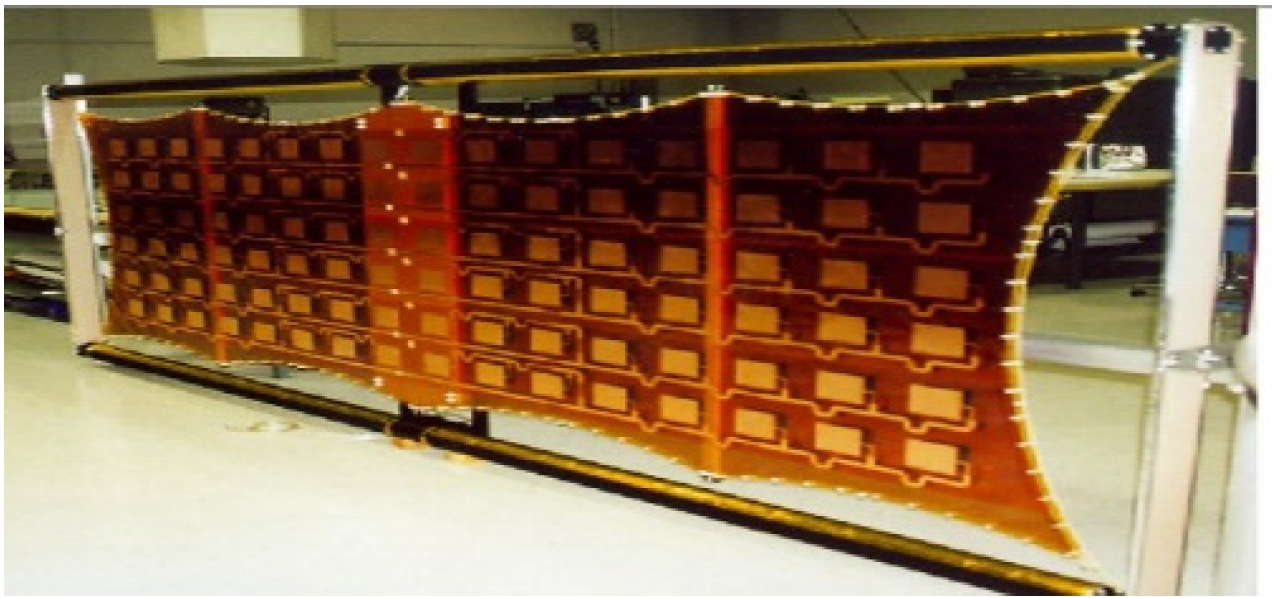

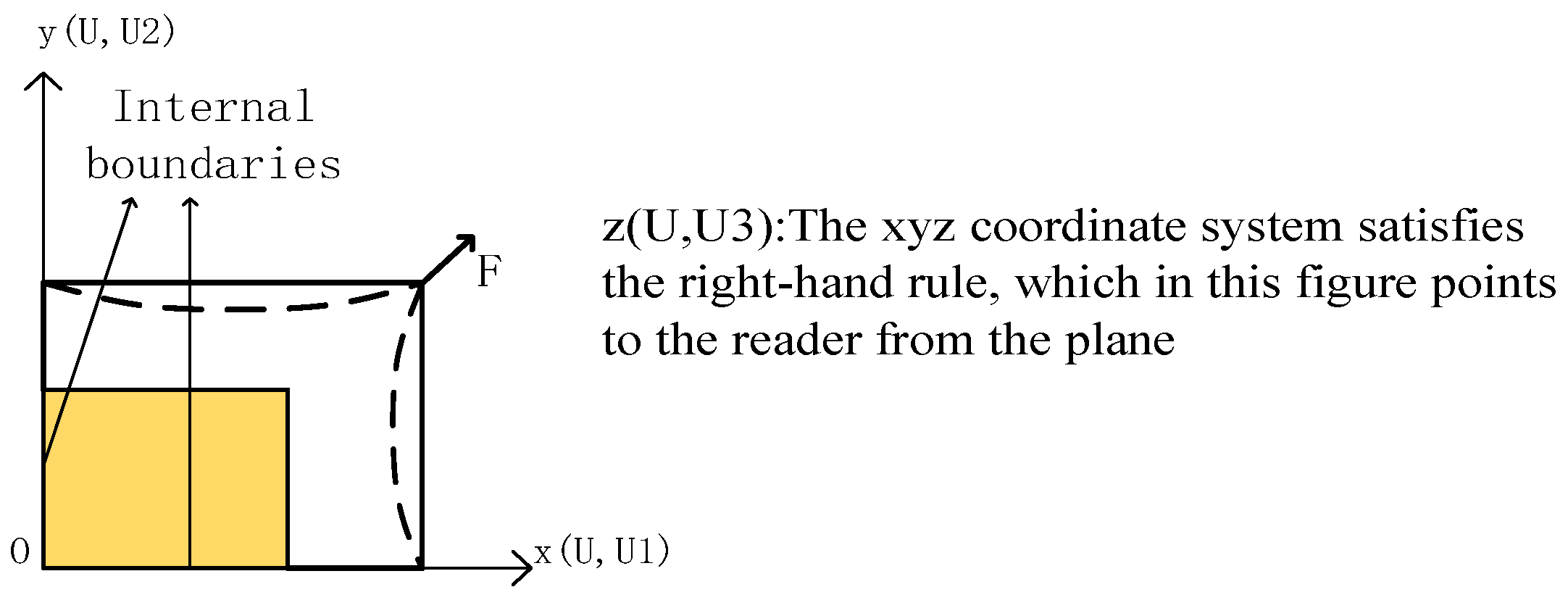

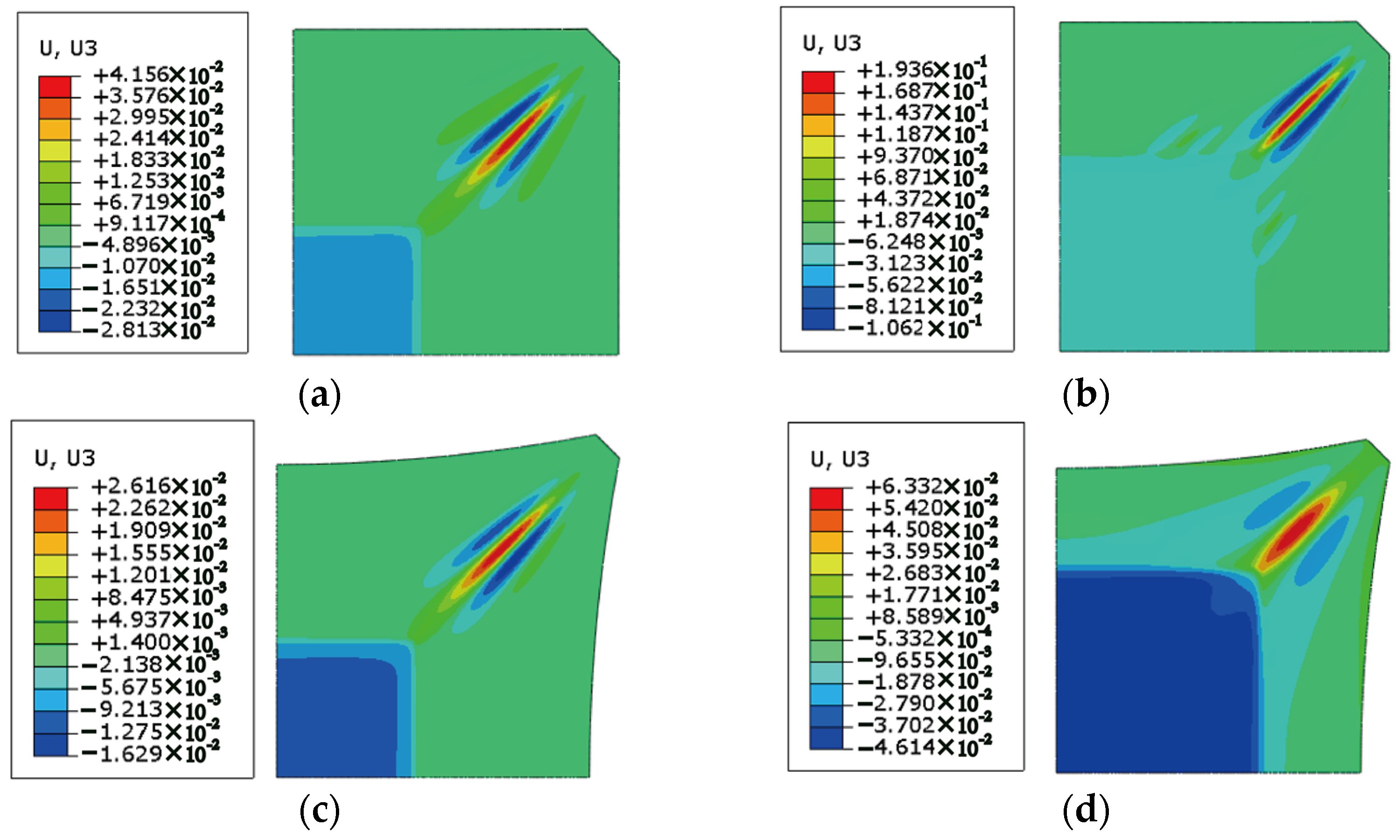
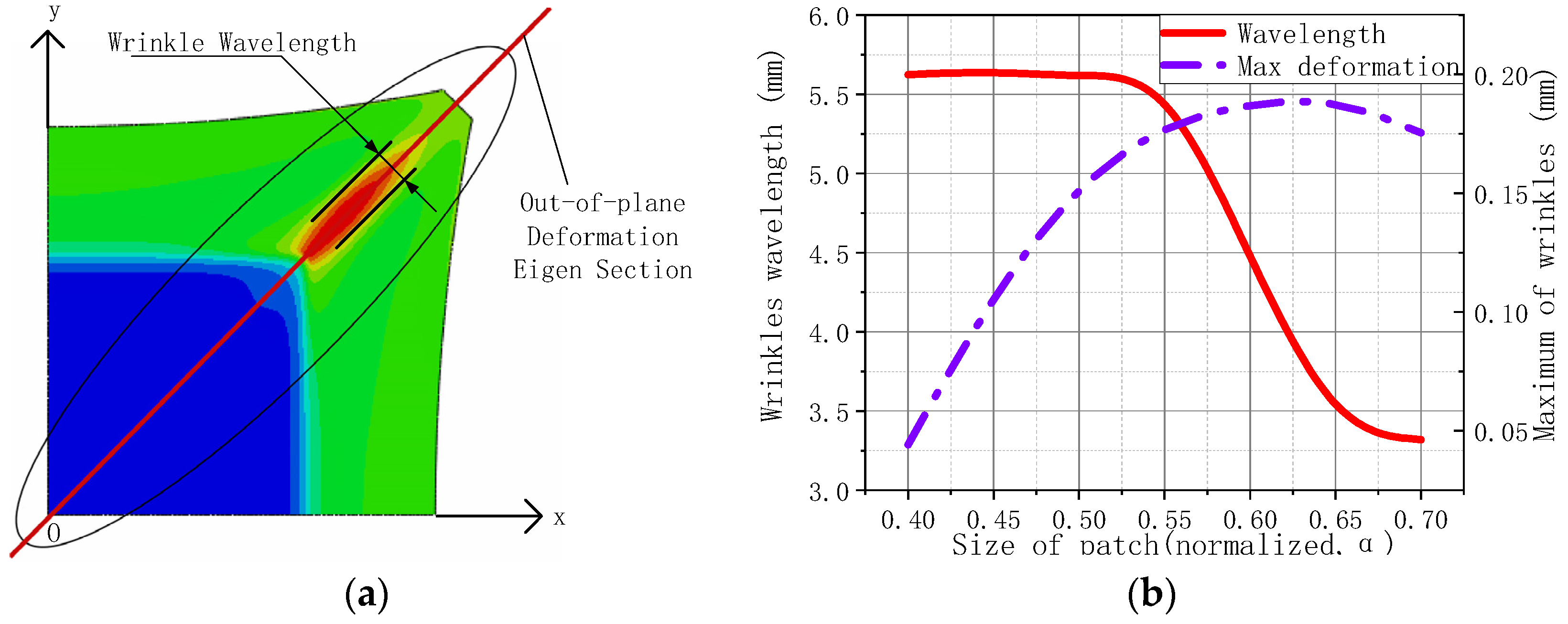

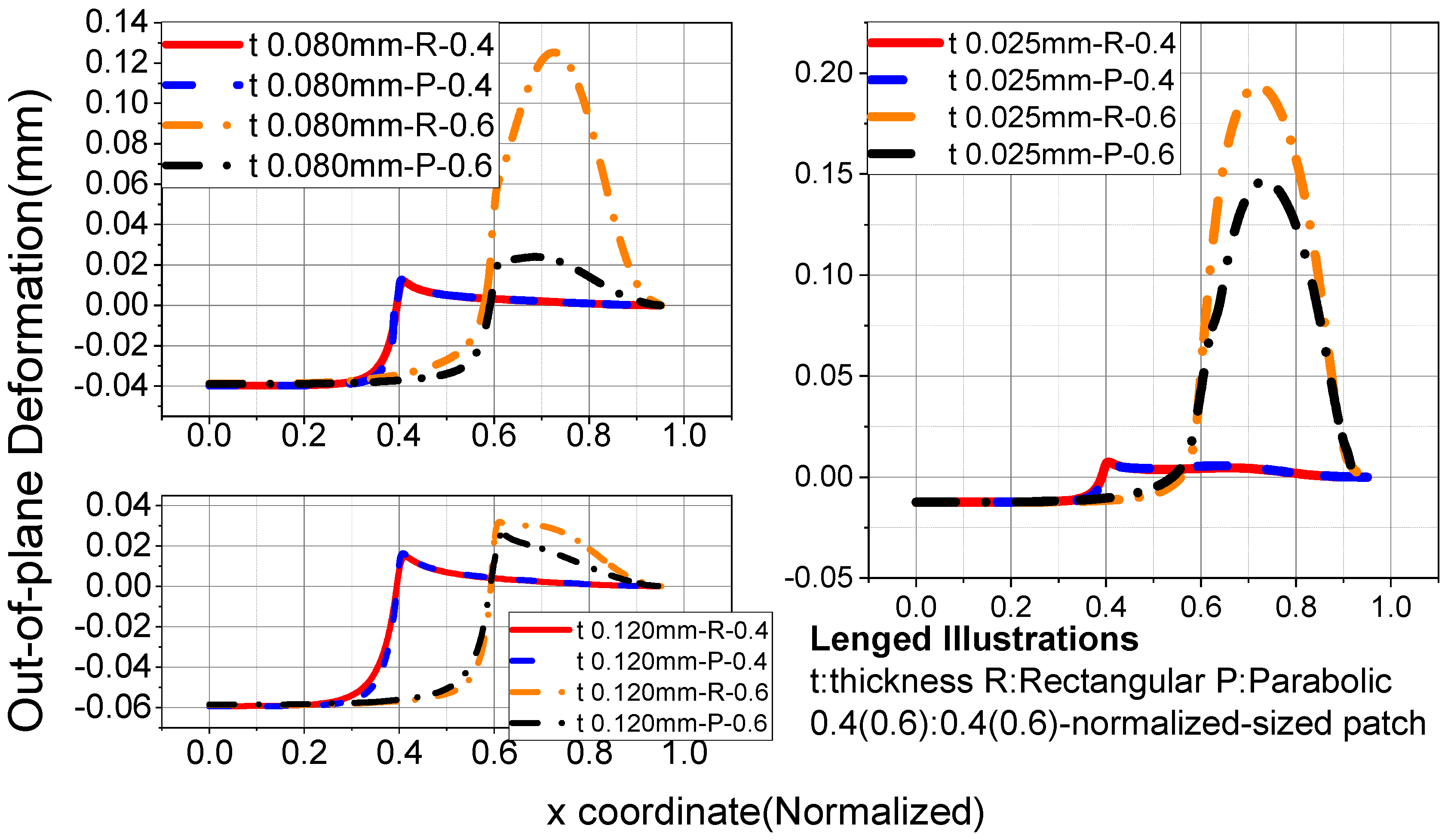
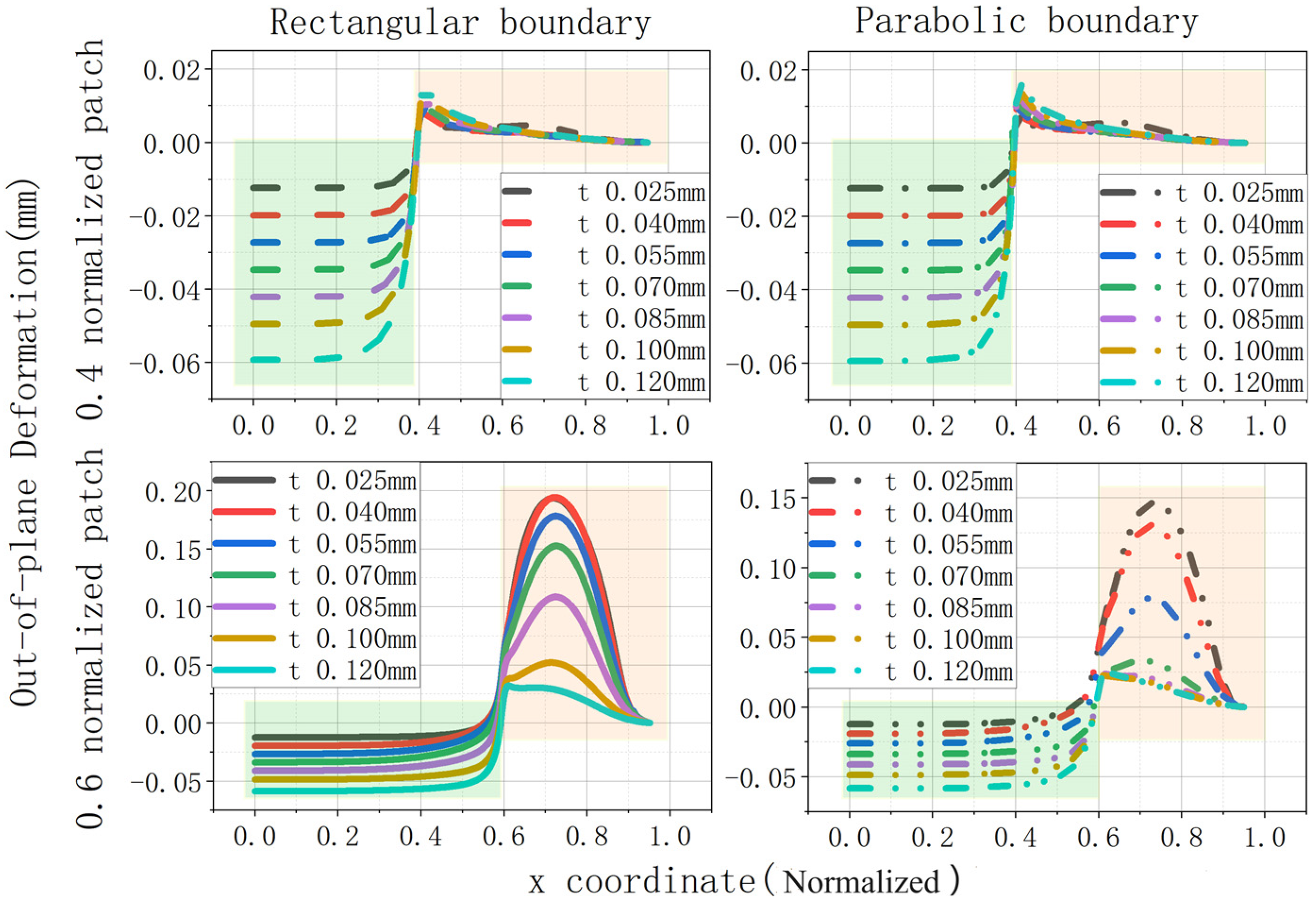
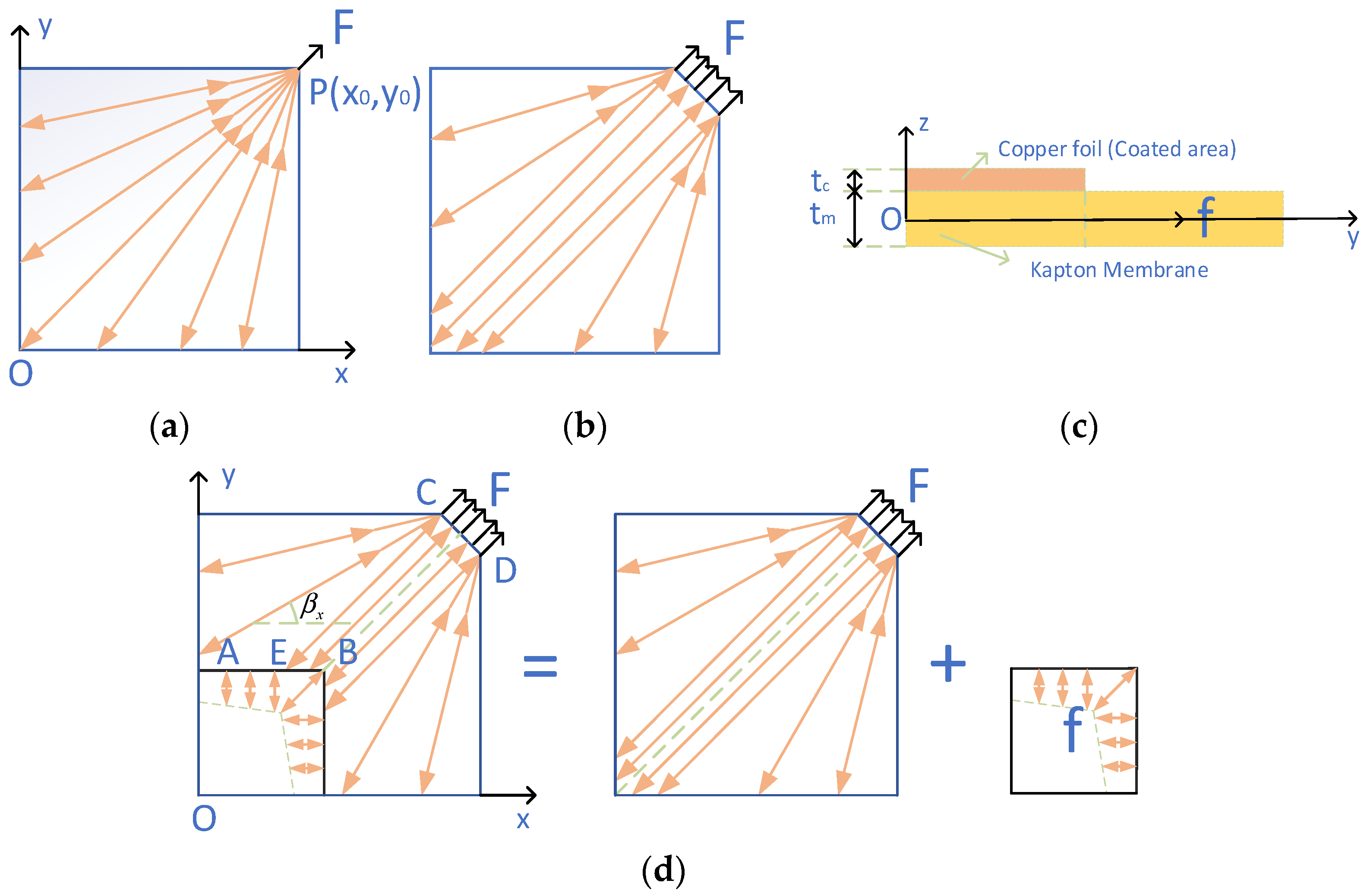

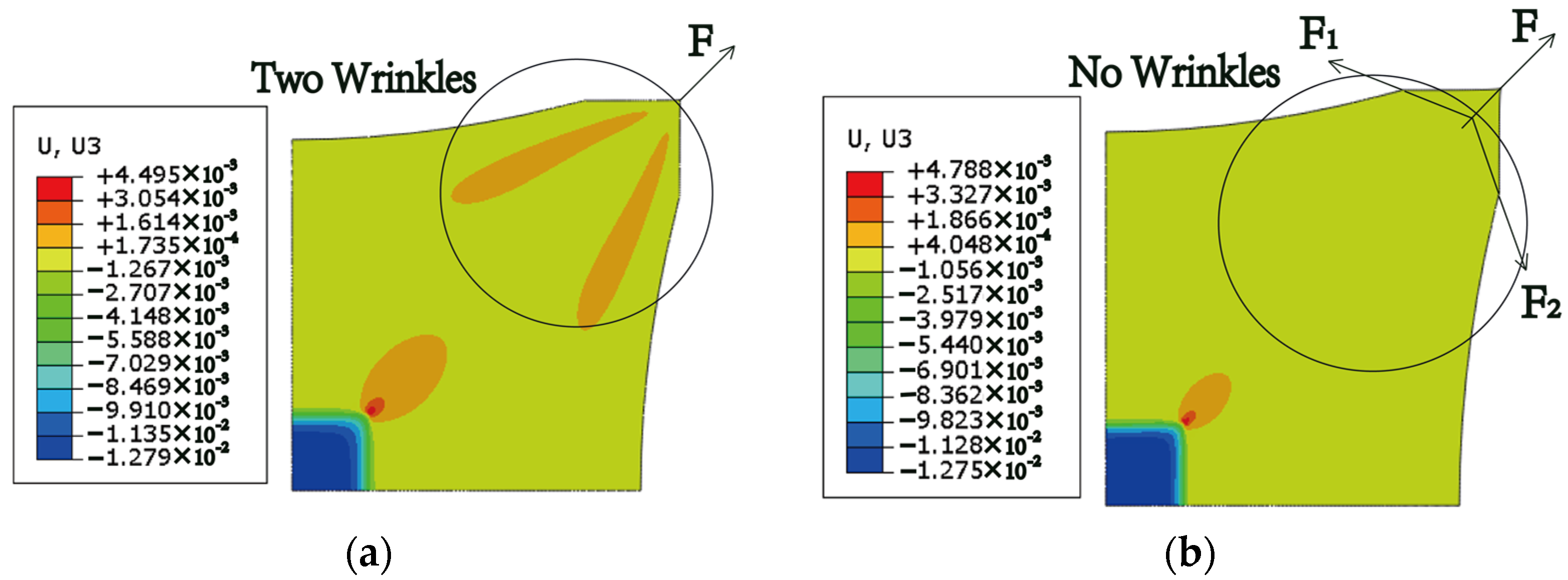
Disclaimer/Publisher’s Note: The statements, opinions and data contained in all publications are solely those of the individual author(s) and contributor(s) and not of MDPI and/or the editor(s). MDPI and/or the editor(s) disclaim responsibility for any injury to people or property resulting from any ideas, methods, instructions or products referred to in the content. |
© 2023 by the authors. Licensee MDPI, Basel, Switzerland. This article is an open access article distributed under the terms and conditions of the Creative Commons Attribution (CC BY) license (https://creativecommons.org/licenses/by/4.0/).
Share and Cite
Zhou, X.; Li, H.; Ma, X. Analysis of Structural Boundary Effects of Copper-Coated Films and Their Application to Space Antennas. Coatings 2023, 13, 1612. https://doi.org/10.3390/coatings13091612
Zhou X, Li H, Ma X. Analysis of Structural Boundary Effects of Copper-Coated Films and Their Application to Space Antennas. Coatings. 2023; 13(9):1612. https://doi.org/10.3390/coatings13091612
Chicago/Turabian StyleZhou, Xiaotao, Huanxiao Li, and Xiaofei Ma. 2023. "Analysis of Structural Boundary Effects of Copper-Coated Films and Their Application to Space Antennas" Coatings 13, no. 9: 1612. https://doi.org/10.3390/coatings13091612




